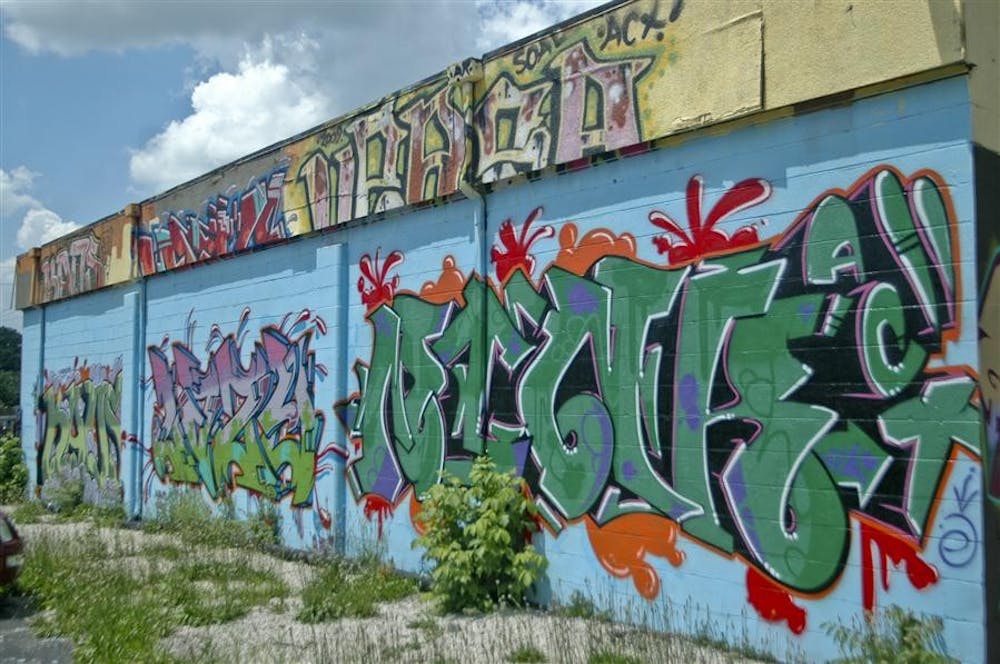Art is in the eye of the beholder. At least, that’s what graffiti artist Michael Burchfield believes.
“Who is to say what is or isn’t art?” Burchfield said.
Burchfield’s murals decorate businesses’ walls around town, including Rhino’s Youth Media Center as well as along the B-line trail.
He almost exclusively paints on legal walls and has been commissioned by both the city and University.
“I’m just trying to put what I do out there,” Burchfield said, “and I actively go talk to business owners on a weekly basis to find space. I also paint on canvases. Anything that sits still long enough to paint, I paint.”
Burchfield was arrested in May for painting on what he considers a free wall in the middle of the night. But he tries to keep it legal.
“I’m not a criminal,” Burchfield said. “I’ve led a pretty decent clean life. Because of one little stupid night, I’ve now been to jail — which wasn’t ever one of the things on my to-do list.”
Burchfield hopes that his arrest doesn’t taint the artistic nature and the community’s appreciation of his work.
“An accusation is an accusation. Once you put it in the public eye, people think it’s truthful,” Burchfield said.
While Burchfield understands why many people dislike graffiti, he hopes that by working with the community, people can learn to appreciate it as art.
Burchfield is just one person in Bloomington who understands the culture hidden behind the paint.
“Graffiti is not an art form based around the idea of trying to become famous,” Burchfield said. “The work speaks for itself.”
Recently, several businesses such as Rhino’s Youth Media Center have provided space for graffiti murals or other paintings.
“It just made sense for us,” said David Britton, executive director of Rhino’s Youth Media Center. “It’s way better than a plain brown wall.”
With an increased popularity and commercial presence comes the inevitable conversation about the merits of graffiti.
“There is confusion about what is identified as graffiti art and what the agenda of the graffiti artist is,” said Malcolm Mobutu Smith, a former graffiti artist and associate professor of fine arts at IU. “It’s a pure avenue for creative expression that isn’t bound by a system or academic regime.”
Most would agree that not all graffiti is art, including Smith and Burchfield.
“By technicality, any art that’s been done is graffiti,” Burchfield said.
Such an encompassing definition poses challenges for graffiti artists in the community. Since graffiti ranges from obscenities scrawled haphazardly on walls to murals painstakingly painted during several days, it can be difficult to explain to outsiders.
“The more complex, thought-out pieces, I think, speak for themselves as opposed to something that took someone a few seconds to paint on a wall,” Burchfield said. “The stuff I do is more complex and takes two to three days to finish.”
Despite its accessibility as an art form, vandalism is inherent in most graffiti, even graffiti art.
“It’s an outlet that’s outside the bounds of the establishment and therefore has an intrinsic level of rebellion built into it,” Smith said.
Graffiti can also be an expression of the disenfranchised.
“They are intentionally challenging our idea of public and private space,” Smith said. “It exposes our nature of maybe infantile possessiveness.”
Other reasons include territorial markings, intentional acts of lawlessness and anarchy, or simply the desire to express oneself.
In Bloomington, most graffiti is considered criminal mischief and is usually a class A misdemeanor for those who are caught and prosecuted. But if enough damage is done, it could be considered a felony.
“There are some pretty significant penalties if you commit criminal mischief,” said Lt. Thomas Lee of the IU Police Department.
Lee, who has been on the force for 15 years, said he doesn’t believe the “graffiti problem” has increased recently but that it is a somewhat static crime.
Even Lee concedes that graffiti can be art.
“If you own the side of a building and you use it, that’s art,” Lee said. “If you don’t own the side of the building and you don’t have permission, that’s criminal mischief.”
Local graffiti artist hopes to quell misunderstanding, turn spray paint into community expression

Get stories like this in your inbox
Subscribe





